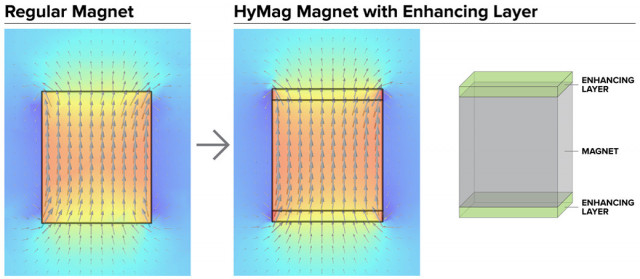![Wind farm outside Fort MacLeod, Alberta, Canada [photographer: Joel Bennett] Wind farm outside Fort MacLeod, Alberta, Canada [photographer: Joel Bennett]](https://images.hgmsites.net/med/wind-farm-outside-fort-macleod-alberta-canada-photographer-joel-bennett_100608718_m.jpg)
Wind farm outside Fort MacLeod, Alberta, Canada [photographer: Joel Bennett]
Saving weight and increasing efficiency and power are among the most common goals for electric-car engineers. The biggest breakthroughs in those specs generally come in batteries. But it's not the only place.
Now scientists at Argonne National Labs have developed a lighter, cheaper, and more efficient motor, called HyMag, that can give equivalent gains and could also be applied to renewable energy generation.
CHECK OUT: Wind and solar cost less than coal for power
The HyMag motor adds "enhancing layers" to the structure of the materials that make up a permanent magnet motor to improve its magnetic flux density. What's more, the scientists can vary the structure and materials to maximize efficiency for different applications, such as electric cars or wind turbines. (HyMag can work either as a motor or a generator.)
The scientists say their new material design can improve flux density by 10 to 30 percent compared with conventional permanent magnet motors. That could give electric cars more range without bigger batteries.

HyMag Motor design from Argonne National Lab
Depending on the application, HyMag motors can require 90 percent fewer rare-earth materials, which can help bring down costs, Argonne says.
“In the past 15 to 20 years, the increase in magnet energy product reached a plateau due to lack of material solution,” said Yuepeng Zhang, one of the Argonne scientists who invented the HyMag motor.
READ THIS: Report: Battery production could offset emissions gains from electric cars
"You have to have higher flux density in order to have more efficiency,” added Argonne group leader of Nanomaterials, Devices, and Systems Kaizhong Gao, co-inventor of the motor. “This additional efficiency will translate into either more energy produced, or you will have less loss.”
The greater efficiency can have compound benefits. In addition to fewer materials, the motors can be lighter for the same amount of power, further reducing materials and cost. The lighter motors can also require smaller housings, saving even more weight and cost. In a statement announcing the HyMag motors Argonne notes that this could allow bigger wind turbines that can run in higher winds to produce more power.